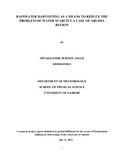| dc.description.abstract | It is clear from the World water quantity that out of total available water, only 0.3% is available
for human consumption. But today even this is getting polluted due to human activities like
mining, industrialization has created acute shortage of potable drinking water. Rain water
harvesting is one of the most ancient and easy methods that can be adopted at urban and rural
level efficiently.
The main objective of this study was to quantify the amount of rainfall over Arusha region and to
determine the maximum probable amount of water that can be harvested.
Arusha region covers total of 86,999 sq. km. of which 3,571 sq. km (4.1%) is water. It is the
largest Region in Tanzania occupying 9.2% of the mainland. The last census in 2012 recorded a
population of 1,694,310 individuals.
Monthly rainfall data for the stations within study area were obtained from Tanzania
Meteorological Agency (TMA). Other data were obtained from Arusha urban water supply and
sewerage authority (AUWSA) was used to determine amount of water supplied and demanded.
National Bureau of Statistics (NBS) 2012 Population and Housing census was used to determine
population of the study area and also to get the number of the main dwellers.
Estimation of missing data was done using arithmetic mean method and the single mass curve
was used to determine data consistency or data homogeneity. Rainfall season was determined by
the use of graphical analysis for annual cycle of rainfall over the Arusha region. The roof
catchment area was estimated to be around 25-30m with standard size room of 3x3m2 was
considered, eave length of 0.6m and elevation angle of 22.5° was also considered. The average
household size of the area was 4.5 and per capita water demand per person per day was estimated
to be 30.5 liters and hence the minimum water demand was calculated. The amount of probable
harvested rainwater was calculated using average monthly rainfall (mm), the runoff coefficient
depending on the common roofing material of the study area and the total roof surface area (m").
The storage reservoir that could sufficiently store the collected rainwater was estimated .
The results showed that the area experience two rainy seasons, March, April, May (MAM) and
October, November and December (OND). | en_US |

